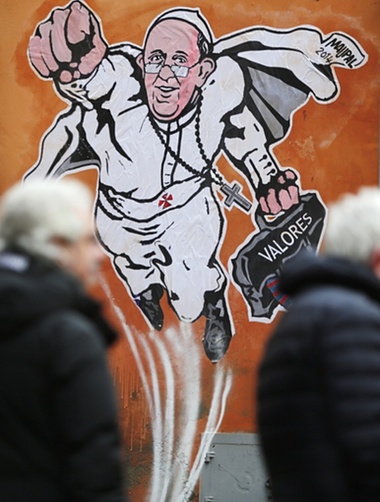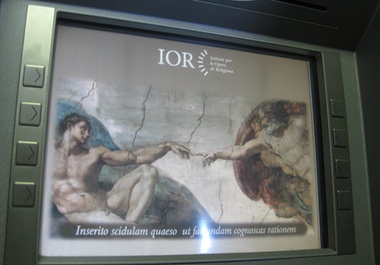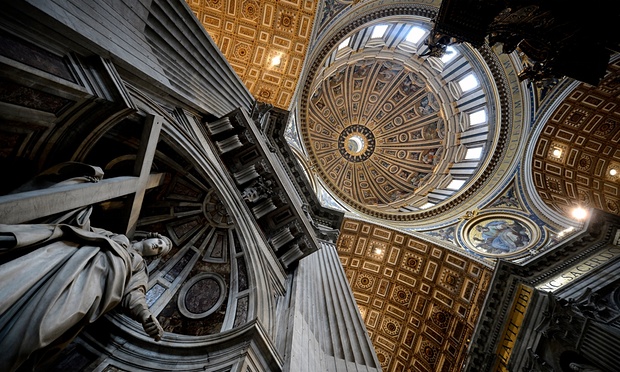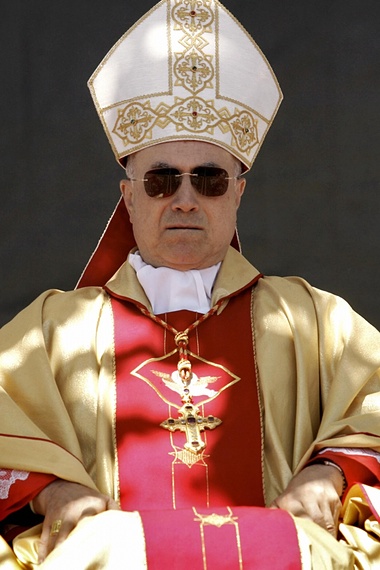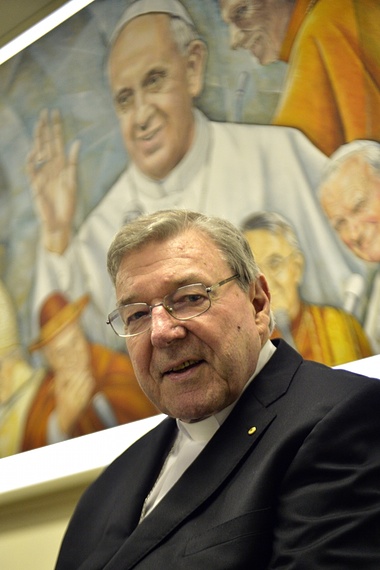Can Pope Francis Clean up God’s Bank?
By Paul Vallely
I was there by invitation. The email had come as something of a shock. The bank’s new press officer – there had never before been such a person – wrote to invite me to enter what has been for generations one of the world’s most secretive institutions. Up a short flight of curved stairs, in a cream and brown marble rotunda, stood eight highly polished tellers’ desks. Priests in long cassocks, nuns in black and brown habits and even the occasional monk queued to deposit cash. These deposits would be wired overseas to pay clergy and build churches, schools and hospitals in the developing world. The official name of the bank is the Istituto per le Opere di Religione (the Institute for Religious Works), known in Rome as the IOR. Since much of its money comes from collection plates, the IOR handles unusually large amounts of cash. Much of the money is sent covertly to churches and voluntary groups in poor countries and failed states without functioning banking systems. All this means that transparency and accountability have never been high on the IOR’s list of desiderata. The man who had emailed me was Markus Wieser, one of two crisis communications experts brought in to change the way the bank related to the wider world. He had been hired from the crisis management specialists Communications & Network Consulting, which has offices in all of the world’s main financial centres. Wieser, a dark-suited polyglot, travels between bases in Berlin, London, Rome and Munich. “It is largely a very simple service,” he said airily as he walked me around the rotunda. He talked smoothly, in a manner equally suited to illuminate as to obfuscate, as he led me through the various floors of the bank’s operation to the chairman’s office at the top. “It is used mainly by religious orders which are too small to have their own finance departments, by employees and pensioners of the Holy See, and by accredited diplomats. They can deposit or send money very quickly and cheaply,” said Wieser. “The other function of the IOR is to safeguard the patrimony of the religious orders who own 85% of the bank’s funds.” In 2013, religious orders had deposited around $3.1bn for safekeeping. The IOR paid out around 1% in interest on that but, on average, invested the money deposited in government bonds at an average of 3.3%. That generated profits of more than $70m. “In banking terms it’s a rather pedestrian service,” said Wieser, who trained as a psychologist as well as in economics. Then he added, with unexpected jocularity: “The main problem was incompetence. The sex and crime was only a little aspect.” * * * The Vatican bank is a comparatively recent institution. Until 1887 Pope Leo XIII hid the Vatican’s ready wealth – a trunk full of gold coins – under his bed. That year he decided to found the Amministrazione per le Opere di Religione to gather more money to do good works. It was only in 1942, at the height of the second world war, that Pope Pius XII gave the organisation a new name and a clear banking mission. Its job was to protect church assets from both Nazi and communist threats. But the new bank was also used to hide from the British and the Americans the deals that the Roman Catholic church in Germany was doing. Some reports suggest that the Vatican was dealing in German insurance policies that benefited from the fact that German insurers did not have to pay out on policies bought by Jews who died in the Holocaust – because their relatives could never certify the deaths. One 1946 memo from a US Treasury agent reported that about $225m in stolen Nazi gold had ended up at the Vatican.
In the 1980s Pope John Paul II used the IOR to send money to Solidarity, the Polish trade union movement that played a key role in triggering the fall of communism in eastern Europe. With the Polish pope’s approval, millions of dollars of covert US aid passed through the Vatican bank to Solidarity. William Casey, the director of the CIA, used to fly to Rome regularly to brief the pope on the fight against communism in eastern Europe. There were suspicions that the bank was used in the 1990s to fund the Contras in Nicaragua and other anti-communist guerrillas in Argentina, El Salvador, and Honduras in operations that reportedly had the blessing of John Paul II. But the dubious dealings continued after the cold war ended. In June 2013, the Vatican’s own financial watchdog uncovered suspiciously large cash withdrawals and deposits in Vatican bank accounts held by the Vatican embassies in Iran, Iraq, Syria and Indonesia. A system aimed at getting money speedily and secretly to difficult places had obvious operational advantages, but it had a big downside too. It became an easy target for those who wanted to use it for criminal purposes. Throughout the 1970s and 80s the chairman of the bank was an American, Archbishop Paul Marcinkus, from Cicero, Illinois. In the 1970s Marcinkus started doing business with Roberto Calvi, president of the Banco Ambrosiano of Milan, who turned out to have links with the Sicilian mafia and the masonic lodge known as Propaganda Due (P2), whose members included powerful figures in the Argentinian military junta. On Calvi’s instructions, banks in Peru and Nicaragua loaned “hundreds of millions of dollars” to companies allegedly under Marcinkus’s control. One of them was said to have financed the purchase of Exocet missiles for Argentina during the Falklands war. In 1982 the Banco Ambrosiano dramatically collapsed. In the aftermath, it emerged that its main shareholder was the Vatican bank. Calvi had set up 10 shell companies in Panama, nominally controlled, via a Luxembourg subsidiary, by the Vatican bank. He had borrowed $600m from 120 foreign banks and lent it to the shell companies, then used the money to manipulate the share price of the Banco Ambrosiano. One of the directors of Ambrosiano Overseas, which was based in the Bahamas, turned out to be Marcinkus – who once observed: “You can’t run the church on hail Marys.” A $1.3bn black hole was found in the Banco Ambrosiano accounts. Calvi fled the country on a false passport, and in June 1982 was found hanged under Blackfriars bridge in London. The Vatican insisted it had no responsibility for the collapse of the bank but nonetheless agreed in 1984 to make a $244m “goodwill payment” to Ambrosiano creditors. Three years later, investigating magistrates in Milan issued a warrant for Marcinkus’s arrest for “complicity in fraudulent bankruptcy”. The warrant was never executed, because the archbishop hid away in the sovereign Vatican state. The scandal came as a severe shock to Roman Catholics around the world. It cost the Vatican hundreds of millions of dollars in legal battles with the Italian authorities and did immeasurable damage to the moral authority of the church. The shadow of shame that fell across the Vatican bank has never fully lifted. * * *
After the terrorist attacks of 11 September 2001, the world’s financial authorities, at the behest of the US government, began to crack down on money-laundering. What previously had been seen as a merely criminal matter became an issue of national security since it could potentially disguise the financing of terrorism. International authorities steadily increased the pressure on private banks that failed to comply with new standards. The Vatican bank, with 25% of its business in cash, and so many of its dealings conducted in secret, was an obvious target: senior officials in the European Union persuaded the Bank of Italy to launch an investigation of its dealings. It was not long before the additional inspections and demands for information yielded results. In December 2009, a routine anti-money-laundering investigation at a UniCredit bank branch, just down the road from the Vatican, found payment slips from several unnamed account holders of the Vatican bank. But when the authorities asked IOR officials to identify the senders of the money, they were told: “Our laws don’t require us to tell you.” The Vatican was a natural tax haven. It was an offshore bank in the middle of Rome that Italians could enter merely by waiting for the traffic lights to change from red to green. In line with the Roman Catholic church’s traditional aversion to transparency, the bank authorities adamantly refused to cooperate with the Bank of Italy’s investigation. The Bank of Italy switched its attention to the 40 commercial banks – known as “correspondent banks” – around the world in which the IOR held accounts and through which it moved billions of euros a year. In September 2010, police discovered ˆ20m being transferred from an IOR account held at the Rome branch of Credito Artigiano to a JP Morgan account in Frankfurt. A ˆ3m payment had been ordered from the same account to another account with the Banca del Fucino in Rome. Both of the recipients were identified only by their IBAN codes. The Vatican bank failed to furnish information on the origin or destination of the funds, as Italian law required. So, in September 2010, Italy’s financial police seized the ˆ23m from the two IOR accounts. Other banks, under pressure from regulators to provide information, asked more and more questions about IOR transactions. The 112 staff at the Vatican bank, mainly Italians, could not, or would not, answer them. In March 2012, American bankers forced the IOR to close the account it held with the US bank JP Morgan. The IOR had moved ˆ1.5bn through that one account in the previous 18 months. In July, the Council of Europe’s anti-money-laundering body announced the Vatican bank was non-compliant on seven of its 16 core standards. The Bank of Italy forced all banks in Italy to close their IOR accounts. The pressure was intensified when the German banking giant Deutsche Bank acted. Its Italian subsidiary managed the Vatican City State’s 80 cash machines and credit card terminals. On 1 January 2013 Deutsche Bank closed them all down. With tourists only able to pay at shops and museums in cash, the Vatican was losing ˆ40,000 a day. The Vatican bank was on the brink of collapse. A few weeks later Pope Benedict XVI dramatically announced his resignation: the first pope to do so for more than 500 years. He was, he said, “no longer physically, psychologically and spiritually capable of handling the duties of office”. The turmoil at the Vatican bank – along with the intrigue and infighting inside the Curia, the Roman bureaucracy, which had been laid bare by the Vatileaks documents leaked by Benedict’s butler – contributed to the burdens Benedict felt he was no longer able to carry. Benedict’s resignation came as a nasty surprise to those in the Curia and the bank who had been taking advantage of the old pope’s frailty and of his inclination to pursue theological matters rather than sound administration. Benedict had, in fact, been aware of the problems and had tried to handle them. He had created a financial regulator, the Autorita di Informazione Finanziaria (AIF), to be a watchdog over all Vatican finances. He had appointed an outside banker, Ettore Gotti Tedeschi, to take over the presidency of the Vatican bank in 2009. But Benedict was outmanoeuvred by those in the Vatican who wanted nothing to change. Perhaps the most formidable member of the old guard was the secretary of state, Cardinal Tarcisio Bertone, a man with a fondness for vestments of fine Italian filetto lace and gold-embroidered mitres set off with a sporty pair of aviator sunglasses. He was a man who became so powerful as Benedict’s first minister that insiders called him the deputy pope. Bertone had been a controversial figure from the outset. The job of secretary of state requires significant diplomatic experience, which Bertone lacked. His background was in disciplining rebellious priests and theologians.
Complaints about him began almost as soon as he took over the top job and started replacing experienced staff with his own people. The Vatileaks documents revealed that he had personally reprimanded the reformist Vatican governor, Archbishop Carlo Maria Vigano, for reporting detailed evidence of nepotism, cronyism and crooked property deals within the Vatican. Soon after, Pope Benedict accepted a recommendation to transfer Vigano from the Vatican to Washington. Other cardinals were so alarmed by this cover-up they sent a delegation to Benedict asking for Bertone to be removed. Among the charges laid against him were poor management, inept diplomacy and inadequate supervision of the Vatican bank. But Benedict refused to sack his old friend. Things got worse. In January 2012 Bertone’s allies forced through a measure removing the independence of the AIF watchdog, compelling it to report to Bertone. When the cardinal wanted the Vatican bank to invest ˆ15m in an Italian TV and film production company, Lux Vide – founded by a friend of Bertone – Gotti Tedeschi refused. In March 2012 Gotti Tedeschi was fired, and Bertone proposed the deal once more. “The message was: ‘The boss wants this,’” a Vatican source told me. The money, which has since been written off, went through. Benedict stepped down on 28 February 2013. In their conclave, as they discussed his possible successor, cardinal after cardinal stood up and criticised Bertone personally, the Curia generally and the bank in particular. The next pope would have a clear mandate for reform. * * * When Jorge Mario Bergoglio was chosen as the 266th pope of the Roman Catholic church, taking his name from St Francis of Assisi, the great saint of the poor, one of the few things his peers knew about him was that, as archbishop of Buenos Aires, he had sorted out financial scandals and maladministration, when church officials had become embroiled with bankers who picked up their credit card bills in return for church endorsements. Bergoglio had acted swiftly, decisively and transparently. Within weeks of taking office, Francis set about tackling the problem of the Vatican bank and the wider finances of the Holy See in three ways. First, he moved swiftly to curb obvious excesses, scrapping the ˆ1,500 bonus traditionally paid to Vatican staff between papacies, and stripping the bank’s five supervisory cardinals of their ˆ25,000 annual stipend. Second, he strengthened existing organisations and brought in no fewer than five firms of top-level management consultants to scrutinize every aspect of Vatican operations. Third, on 24 June 2013, four days before Scarano was arrested, he set up a commission of external secular financial and legal experts to work out what should be done. A month later, in July, he set up a second group of outsider financiers to look at every aspect of the rest of the Vatican financial and economic portfolio. The two groups were told to think the unthinkable – including whether the Vatican bank should be simply shut down. Inside the Vatican bank, the grand office of its president was taken over by Elizabeth McCaul. She was a Roman Catholic, and a mother of seven, but also the partner-in-charge of the New York office of the management and regulatory compliance experts Promontory Financial Group. The president’s expensive leather furniture and fine oriental rugs were pushed to one side. Beneath the crystal chandeliers and heavy gilt-framed oil paintings, rows of desks were crammed in. At each desk, three individual computer terminals were set up for the teams taking over. The baroque clerical drawing room suddenly looked like a city trading floor. McCaul – a former superintendent of banks for the state of New York who had helped stabilise the banking sector after the 9/11 attacks – had flown in 25 regulatory specialists from the US. They had been given six months to trawl through every single one of the Vatican bank’s 19,000 accounts. “It has been a huge cleaning effort,” Markus Wieser told me as we toured the high-security building. The team began by sorting through computer scans of the passport of every account holder, which were painstakingly cross-checked against the names and faces of bank records. “The activities were designed to make this place compliant with Vatican law and align Vatican law to international standards.” Archbishop Paul Marcinkus, chairman of the bank in the 70s and 80s, said: ‘You can’t run the church on hail Marys’ ? The US outsiders worked in seven work streams, checking the information on the account of each and every customer. They set up new standard rules. They established an IT system to automate the rules by running an algorithm over every transaction in each account to see whether it fitted the usual customer profile. Later they did the same with the accounts of Monsignor Scarano’s old stamping ground, APSA. What they uncovered was embarrassing for the Italians who had previously been in charge. The US banking experts found poor cashflow checks, inadequate documentation, ignorance about due-diligence procedures and a complex system of proxies that clouded who really controlled many accounts. When senior IOR officials were asked by Promontory staff how – amid such chaos – they answered to the regulator, they replied: “We answer to God.” Well, they were told, now you will answer to more earthly authorities. The Americans worked through 16,900 accounts before they returned to the US. Within six months 3,300 accounts were shut down. “The vast majority were dormant accounts with a negligible balance,” said Wieser. “Or were held by individuals no longer eligible to hold an account under the new rules introduced by Promontory. But some, Wieser revealed, had “been frozen in the course of regulatory or criminal proceedings”. The team found 200 serious irregularities, each of which triggered a “suspicious transaction” report that was sent to the bank’s regulator, the AIF. One case Promontory referred to the regulator was the Lux Vide production company investment the bank made – against the advice of its staff and supervisory board – on the insistence of Cardinal Bertone. In May 2014, the Vatican denied that the 79-year-old cardinal was under investigation by Vatican magistrates. But, according to Wieser, a case on the transaction has been opened. The entire supervisory board of the AIF was sacked and replaced by Francis a month later, in June 2014, sweeping out all Bertone’s allies. Few in Rome expect the Bertone case to advance to the Vatican prosecutor. But the fact that a pope’s former second-in-command is under the scrutiny of the regulator is a measure of how far Francis’s revolution has advanced. * * * Cardinal George Pell is a big man. His physique – broad and 6ft 3in tall – is that of a priest who played professional rugby as a young man. An Australian, and the son of a heavyweight boxing champion, he has a personality to match, belligerent and blunt. He is conservative both doctrinally and politically. He is a climate-change denier who has been, at the very least, grossly insensitive to the victims of sex abuse in Sydney and Melbourne.
Yet, for all his conservatism, Pell had for years been a vocal critic of the Roman Catholic bureaucracy and its corruption under the previous two popes. He knew what he was talking about. The pugnacious Australian had knocked the finances of the archdiocese of Sydney into shape during his time in charge, leaving a legacy of nearly AU$1.2bn after 12 years. It was not a one-off. He had done the same thing in the much larger archdiocese of Melbourne before that. So, when the two financial thinktanks delivered their reports a year into the papacy, it was Pell whom Francis asked to lead the complete overhaul of Vatican finances. “Francis has played it very cleverly,” said one seasoned Vatican diplomat. “It was a masterstroke to get Cardinal Pell involved. He is a really tough nut. And it is far better to have him in the tent shouting out than outside shouting in.” The Vatican bank was not to close, but it was to be stripped of its function of managing investments. The post of secretary of state – Bertone’s old job – was to lose control of Vatican finances. The Amministrazione del Patrimonio della Sede Apostolica was to confine itself to its original function of managing the Vatican’s property, purchasing and personnel portfolio. A new overarching finance ministry, the Secretariat for the Economy, was established. So was a new Vatican asset management unit. Pell was announced as the new supremo over it all. He was also one of nine prelates Francis chose to be in his new cabinet of cardinal advisers, the C9. The pope was careful not to place too much power in one man’s hands. Though Pell has been given unprecedented reach over all Vatican finances, he is overseen by a supervisory council chaired by another of the Pope’s trusted C9 cabinet, Cardinal Reinhard Marx, the Archbishop of Munich. “It’s a separation of powers,” Pell told me over breakfast in the Domus Australia, the boutique hotel he established for Australian pilgrims to Rome three years before. It was just a few days after my tour of the bank. “It’s designed so there will be no unique focus of power.” Nor is it exclusively clerical. “Half the members are lay people who have an equal vote with the cardinals.” To add to the system of checks and balances that Francis has introduced, there will be a new position of auditor general, a non-cleric with powers to go “anywhere and everywhere” in the Vatican to conduct spot checks as well as annual audits. Pell has moved swiftly. All Vatican departments, for the first time in their history, have been told they must produce quarterly reports comparing actual spending with budgeted expenditure – standard practice in the secular business world. There was initial resistance. So, Pell sent out a 45-page manual to all 200 Vatican departments and allied bodies outlining the international standards of accounting and budgeting he is enforcing. “The penny dropped after that,” Pell said. “People realised the game has changed.” The old guard has not taken the changes lying down. Early on, the pope placed an old friend, Monsignor Battista Ricca, inside the bank to be his eyes and ears there. When Ricca, who had been given authority to access all documents, got too assertive, dark forces within the Curia leaked a story about him to the Italian press. It claimed that Ricca had homosexual affairs while serving as a papal diplomat in Uruguay a decade before. One headline announced: “Catholic bishop in charge of cleaning up Vatican finances got stuck in a lift with a rent boy.” The Vatican denied the claims, but it was widely assumed that Ricca would have to resign. However, Pope Francis was not to be so easily manipulated. He saw the leaks behind the story as an attempt by conservatives to undermine his Vatican bank reform programme by trying to discredit one of his key reformers. When Ricca offered to go, the Pope refused to accept his resignation. When the press asked Francis about Ricca’s gay past, he came out with the line which was to become the totemic phrase of the early part of his papacy: “If a person is gay and seeks the Lord and has good will, who am I to judge?” As Pell’s reforms began to bite, similar dirty tricks were deployed against him. Stories were leaked to the Italian press, repeating Pell’s more controversial attitudes on clerical abuse. (Some years before, he had claimed that the Roman Catholic church should be no more responsible for the abuse of children than a trucking company is for a driver who picks up and molests a woman while on the job. Pell’s record on predator priests is currently under scrutiny by a Royal Commission in Australia.) More damaging to his role as Vatican finance supremo, fictions were put about that he was submitting extravagant expense claims. Pell shrugged his shoulders when I asked him about it. “That’s part of the game,” he said. “It doesn’t greatly cause me concern.” At a consistory of cardinals earlier this year, attempts were made by old-guard prelates to curb Pell’s powers. Pope Francis would not allow it. The pope was clear that no compromise could be permitted in the pace of change. His watchword was the Italian fretta, meaning faster, stronger, more. Francis has not just set the wheels in motion, he is following up. “We speak every fortnight,” Pell revealed – and more often, if the Australian prelate requires help or advice. “He understands money and he’s interested in it. Honesty, efficiency and transparency are his priorities.” The pope has backed the reform effort at every turn. “Whenever there were things we couldn’t clean up on our own, he’s been there to support us.” Some might see an irony in that. The man who began his pontifical ministry demanding “a poor church for the poor” has ended up establishing the Vatican asset management unit. But anyone acquainted with the pope’s track record from his time in Buenos Aires would recognise in this the combination of an audacious prioritising of the poor and a canny understanding of the politics of how change is achieved in this world. Francis told his financier advisers at their first meeting in July 2013 that “sound financial management was a pillar of his greatest mission: aiding the poor and underprivileged”. What that meant, said Cardinal Pell, is that “the Pope wants to maximise the amount of money coming in so that it could be spent on the poor and the works of the church. Because we’re trying to help people is no reason why we should be inefficient, or not transparent, or open to being robbed.” As he rose from the breakfast table to head off to meet the pope, I reminded Pell that he had once said he would only be happy when the Vatican bank was “off the gossip pages”. Had he managed that? He smiled grimly: “Not quite.” Adapted from Pope Francis: Untying the Knots – The Struggle for the Soul of Catholicism by Paul Vallely, published by Bloomsbury on 27 August. • Follow the Long Read on Twitter at @gdnlongread, or sign up to the long read weekly email here This piece was amended on 13 August to correct an error. The Contras operated in Nicaragua, not El Salvador.
|
.
Any original material on these pages is copyright © BishopAccountability.org 2004. Reproduce freely with attribution.
